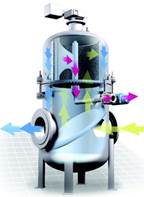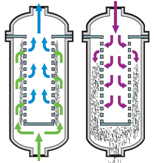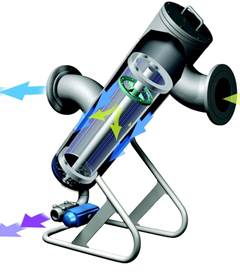Automatic Strainers
Differences between backwashing and mechanically cleaned designs
Automatic strainers and filter
systems support continuous flow rate applications by reducing or
eliminating personnel that would otherwise be required to manually
operate duplex strainers. The styles described below are the most
common types used for industrial applications and after reading this
article you should have a better understanding of which style would work
best for your application.
Flushing Strainers
This type of strainer is a modification of
a standard basket strainer having a drain valve at the bottom of the
element chamber, which can be manually or remotely actuated.
Opening the drain valve causes a "toilet bowl effect" of flushing
retained solids out the drain, thus this works best with non-deformable
solids and for lower solids concentrations. Since the flow is not
reversed through the element, deformable and fibrous solids have a
tendency to remain embedded and will require manual cleaning at some
point. This is a very inexpensive design and typically shipments
can be made within 2 weeks or less.
 Backwashing Strainers and Filters
Backwashing Strainers and Filters
Automatic strainers and filter systems are
designed to minimize any interaction with personnel and there are many
benefits. Elimination of physical lifting of heavy (filled)
strainer elements, exposure to cleaning chemicals and the physical
scrubbing itself are all aspects which reduce labor hours required to
keep the system operating continuously.
Automatic systems are generally limited to
particle concentrations of <=200 PPM and require either electricity or
instrument quality compressed air to operate. Compared to duplex
strainers, automatic strainers typically cost the same or less for
pipelines >6".
Backwashing refers to the temporary
reversal of flow through one or more filtration elements. During
normal operation, large particles either become stuck against the
element surface or fall to the bottom of the vessel. The particle
size allowed to pass through to the outlet depends upon the opening size
of the element.
 Backwashing occurs when a drain valve is
opened such that the differential pressure between atmospheric and the
system pressure causes reversal of flow across the element, dislodging
particles to a common drain. Unlike the aforementioned "flushing
strainer", the reversal of flow through the element is concentrated by
the system design. The Eaton model 2596 illustrated above is
typical for high flow water systems common in power plants, steel mills
and paper mills. These have a hollow nozzle arm, which has the
same length as the element, and this arm slowly rotates across the
surface of the element, amplifying the differential pressure and
reversal of flow effect; the particles are essentially vacuumed off the
element.
Backwashing occurs when a drain valve is
opened such that the differential pressure between atmospheric and the
system pressure causes reversal of flow across the element, dislodging
particles to a common drain. Unlike the aforementioned "flushing
strainer", the reversal of flow through the element is concentrated by
the system design. The Eaton model 2596 illustrated above is
typical for high flow water systems common in power plants, steel mills
and paper mills. These have a hollow nozzle arm, which has the
same length as the element, and this arm slowly rotates across the
surface of the element, amplifying the differential pressure and
reversal of flow effect; the particles are essentially vacuumed off the
element.
 Tubular backwashing designs are made for finer particle
retention and rely solely upon the differential pressure for element
cleaning. The elements are specifically designed to evenly
distribute reversed flow to ensure efficient element cleaning.
Tubular backwashing designs are made for finer particle
retention and rely solely upon the differential pressure for element
cleaning. The elements are specifically designed to evenly
distribute reversed flow to ensure efficient element cleaning.
Backwashing systems are most commonly used
for water applications because the backwashing procedure may require up
to 5% of the system flow for a few minutes each time backwashing occurs.
Therefore, your process needs to tolerate a temporary reduction in flow
or the pump needs to be capable of delivering additional flow during the
backwashing process.
Backwashing strainers function most
efficiently when the system pressure is >30 PSI as that equates to a
differential pressure of about 15 PSI (because you are discharging to
atmospheric pressure).
The backwashing function can be initiated
by timer, differential pressure or manually with the push of a button.
Mechanically Cleaned Elements

As with simplex basket strainers, particulate enters
into a cylindrical, tube shaped element, having no bottom or top.
The bottom end of the vessel is where the drain port is located and thus
large/heavy particles will naturally fall to the drain or purge area of
the vessel. The particles too large to pass through the element
become stuck to the surface and perhaps some are wedged into the
openings.
Cleaning occurs when a spring-loaded disc
traverses the element interior. The disc is comprised of four
sections; spring loading ensures a constant pressure is exerted to the
element surface. The disc material, which is available in UHMWPE,
PTFE and PVDF, pushes the retained particles downwards to the purge
chamber. The user can adjust the frequency of strokes. An
advantage of this style is that frequent strokes help ensure a
consistent differential pressure, minimizing pressure spikes and changes
in flow rate.
The bottom of the vessel, the "purge
chamber", is shaped to increase purging efficiency. An automated
valve opens; the system backpressure pushes the fluid and accumulated
particles through the valve prior to closing. The entire cycle
lasts only a few seconds. The frequency of purging is also user
settable.
Mechanically cleaned systems provide very
efficient performance for applications which have a continuous and
predictable solids loading characteristic.
Loss of process fluid is minimized, making
this design well suited for non-water fluids, which either have value or
are more expensive to dispose. Mechanically cleaned elements are
excellent for viscous fluids such as plastisol.
Designs are available to operate the
stroking either pneumatically or electrically and some designs are
self-contained, meaning there is no penetration through the chamber
cover to actuate the stroke.
Just about any filtration application can
be automated; the design that is best for you depends upon the
requirements of your application. Our training and experience
enables us to gather the right information and guide you to the best
configuration. Additional information describing our automatic
strainers is online at
https://automaticstrainers.com.



